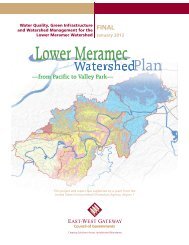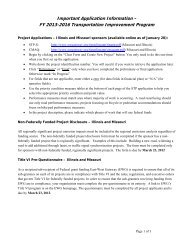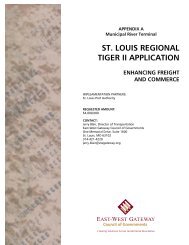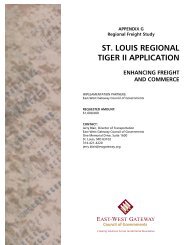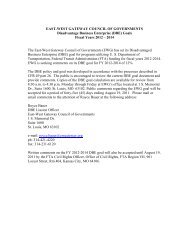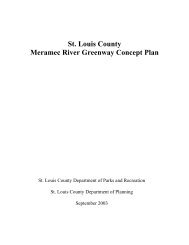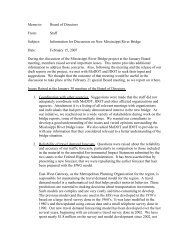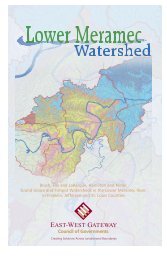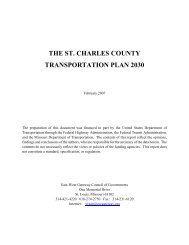Jefferson County - East-West Gateway Coordinating Council
Jefferson County - East-West Gateway Coordinating Council
Jefferson County - East-West Gateway Coordinating Council
You also want an ePaper? Increase the reach of your titles
YUMPU automatically turns print PDFs into web optimized ePapers that Google loves.
A Regional Overview All-Hazard Mitigation Plan 111<br />
are loss of human life, economic loss including property damage, lifeline disruption and<br />
environmental damage.<br />
While the definition varies from place to place, it generally means if failure of a high-hazard<br />
dam occurs, there probably will be loss of life. I t must be emphasized that this<br />
determination does not mean that these dams are in need of repair--these dams could be<br />
in excellent condition or they could be in poor condition. "High-hazard" just reflects the<br />
dam's potential for doing damage downstream should it fail.<br />
High-hazard potential dams exist in every state and affect the lives of thousands<br />
downstream. The current issue and debate is over the increasing number of these highhazard<br />
structures--not because more high-hazard dams are being built, but that more<br />
development is occurring downstream. Dam and reservoir safety regulators generally have<br />
no control over local zoning issues or developers' property rights. So this issue continues to<br />
worry regulators as the trend persists.<br />
Some dams are considered to have a greater hazard potential than others. There are<br />
approximately 10,000 state-regulated "high-hazard" potential dams in the U.S. "Highhazard"<br />
is a term used by a majority of state dam safety programs and federal agencies as<br />
part of a three-pronged classification system used to determine how hazardous a dam's<br />
failure might be to the downstream area. Historically, dams that failed had some<br />
deficiency, as characterized above, which caused the failure. These dams are typically<br />
termed "unsafe." Currently, there are about 2,000 "unsafe" dams in the U.S. There are<br />
unsafe dams in almost every state. (A majority of states and federal agencies define an<br />
"unsafe" dam as one that has been found to have deficiencies that leave it more susceptible<br />
to failure.)<br />
Hazard Event History<br />
Thousands of people have been injured, many killed, and billions of dollars of property<br />
damaged by dam failures in the United States. Dam failures at Lawrenceton in 1968,<br />
Washington <strong>County</strong> in 1975, Fredericktown in 1977, and a near failure in Franklin <strong>County</strong><br />
underscored the problem of unsafe dams in Missouri in 1978.<br />
Frequency of Occurrence<br />
Table F51 below summarized the frequency of dam failures in Missouri. Four dams failed<br />
in ten years.<br />
TABLE J51 RECENT DAM FAILURES IN MISSOURI<br />
Community Date<br />
Lawrenceton 1968<br />
Washington <strong>County</strong> 1975<br />
Frederickton 1977<br />
Franklin <strong>County</strong> (near failure) 1978



